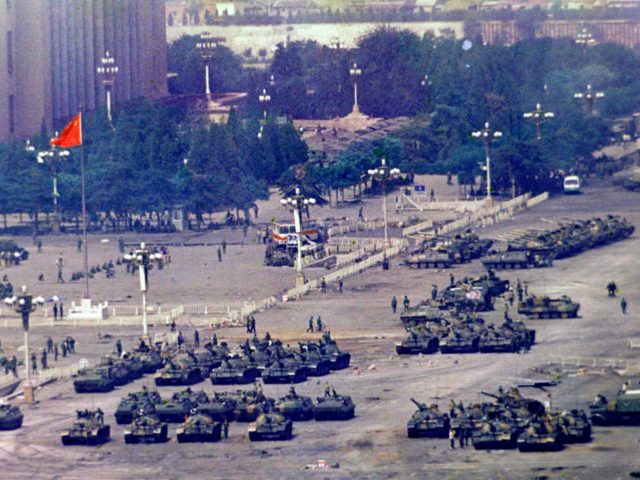Ma Fung-kwok, a pro-establishment lawmaker in Hong Kong’s Beijing-controlled government, took Chinese Communist Party (CCP) history revisionism to the next level on Thursday by claiming no one died in Tiananmen Square in 1989.
Hong Kong officials have canceled the marches and vigils normally planned for June 4, the anniversary of the Tiananmen massacre, during which Chinese forces slaughtered as many as 10,000 pro-democracy activists. No conclusive death toll exists due to Chinese state secrecy and the pervasiveness of the repression, which included Chinese officers attacking wounded protesters in hospitals.
On Wednesday, Hong Kong’s June 4 Museum announced it was temporarily closing due to a suspiciously-timed “licensing investigation” by the city’s Food and Environmental Hygiene Department.
The exact number of people killed in the Tiananmen Square massacre is the subject of much debate, because the Chinese government refuses to release official records, suppresses discussion of the event, and tightly controlled foreign media organizations that were on the scene on June 4, 1989. Reporters who tried to cover the massacre as it happened were beaten and shot by Chinese troops.
In an interview with the Hong Kong Free Press (HKFP) on Thursday, Hong Kong legislator Ma Fung-kwok said the death toll from the Tiananmen massacre was greatly exaggerated by anti-Chinese foreign media and no one actually died in the square at all.
When the veteran lawmaker was asked why he urged Hong Kongers to stay on the island and protect their autonomy in the wake of the massacre since the Chinese government was clearly a lethal menace to freedom-minded Chinese, Ma claimed he could not remember signing such a declaration – and if he did, well, times have changed since then.
As HKFP reminded him, Ma and numerous other prominent islanders signed a declaration called “Hong Kong People Building Hong Kong” after the Tiananmen massacre that urged Hong Kongers to remain in the city, and implicitly offered refuge to frightened Chinese citizens fleeing the brutal Communist tyranny.
Tiananmen Square was widely (and presciently) seen at the time as a grim omen for Hong Kong’s freedom when it was handed over to China by the United Kingdom in 1997. The declaration Ma signed urged Hong Kongers to work hard on shoring up their democratic systems and fortifying their freedoms before China took possession of the city.
An interesting feature of Ma’s 1989 declaration is that it included “five demands” – just as the 2019 protest movement had five famous demands of the regime Ma now obsequiously serves. That resemblance might be one of the reasons he grew nervous when his interviewers queried him about the declaration.
“It’s meaningless to ask. The social environment, the situation of the country, and the international environment was completely different 30 years ago,” Ma told the HKFP – a darkly comical excuse, given that China has only grown more authoritarian and menacing over the past three decades, especially regarding Hong Kong, whose promised autonomy was summarily destroyed by China’s tyrannical “national security law” this spring.
“To put it simply, I said back then to ‘stay in Hong Kong to build Hong Kong,’ I think it’s not a problem, you can say that today. How can you take something from 30 years ago to say that it’s still effective today?” he stammered. “Do you remember what you said 30 years ago?”
Ma claimed he has become a truth-seeking student of the Tiananmen Square incident, spending years trying to “figure out what actually happened,” and has become convinced that contemporary reports of bloody horror from global media were “not real, not accurate, not complete, or completely escaped that reality.”
In particular, Ma said he has “come to accept the fact that no one died on Tiananmen Square.”
When his interviewers apparently expressed astonishment at this declaration, Ma clarified that he watched some sort of bombshell history-revising report in foreign media a while ago, and while he could not remember where it came from or exactly what it said, it convinced him that some people might have gotten themselves killed on June 4, 1989, but none of them did it within the boundaries of Tiananmen Square proper:
“My main point is that a lot of reports have not been corrected, those saying that people died at Tiananmen Square, the army and police fire shots, tanks rolling around…” said Ma.
“There is a Spanish television channel with a documentary that came out years ago, they were the last crew to leave Tiananmen Square, and they didn’t see it [those scenes],” said Ma. “It’s not that no one died on June 4, even officials said people have died on that day, just not at Tiananmen.”
The HKFP gamely noted that some foreign reporters have said they watched the Chinese military murder people in the streets around the square, but could not see what was happening in the square itself – which is not surprising since, as mentioned above the Chinese state’s heavily armed goon squad brutalized any reporter who tried to get into the square.
As for Ma scoffing at the reports of “tanks rolling around” Tiananmen in June 1989, he might have forgotten that some of the most famous photographs taken in the history of journalism show exactly that.

COMMENTS
Please let us know if you're having issues with commenting.